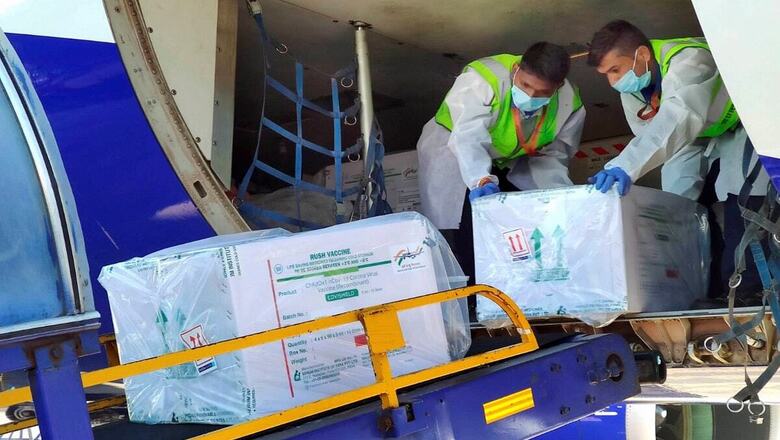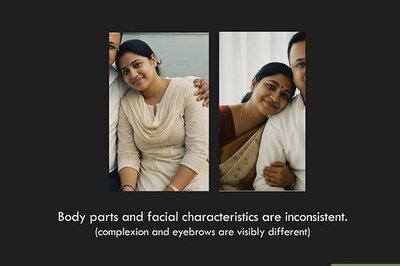
views
Earlier this week, the Centre finalised purchase orders for 1.65 crore Covid-19 vaccines – 1.10 crore Covishield doses and 55 lakh Covaxin doses. The purchase order set off one of the most crucial steps ahead of the first phase of vaccination — that of transporting the vaccines across the length and breadth of the country.
After reaching different states, the vaccine shipments were stored in designated spots ahead of the national vaccination rollout on January 16.
News18 explains how the vaccines were transported, where they will be stored and what will happen at a vaccination site.
How are the vaccines getting transported from manufacturing facilities?
Serum Institute of India and Bharat Biotech began dispatches of their vaccine consignments on Tuesday and Wednesday, respectively. Serum’s initial vaccine consignment of about 1,088 kg left its Pune facility in special trucks for the city airport. By air, they were dispatched to Delhi, Chennai, Kolkata, Guwahati, Shillong, Ahmedabad, Hyderabad, Vijaywada, Bhubaneswar, Patna, Bengaluru, Lucknow and Chandigarh.
Later, on Wednesday, Bharat Biotech dispatched via air its first batches of vaccines (each vial containing 20 doses) to Ganavaram, Guwahati, Patna, Delhi, Kuruksehtra, Bengaluru, Pune, Bhubaneswar, Jaipur, Chennai and Lucknow.
What happened when they arrived in different cities?
Once vaccines leave the manufacturing facilities, Centre and state governments coordinate to monitor their transport to the storage facilities. According to the Union Health Ministry, the vaccines are first transported to the Government Medical Store Depots (GMSD) in Karnal, Mumbai, Chennai and Kolkata.
From these four nodal locations, the vaccines are then transported in refrigerated or insulated vans to state vaccine stores. There are 37 state vaccine stores, which are meant for bulk storage.
Where are the vaccines transported to after they arrive in state stores?
Once the consignment of vaccines arrives at a state vaccine store, it is the responsibility of the respective state governments to ensure that the vaccine vials reach the eventual vaccination centre safely and with minimal or zero waste.
The district and sub-district stores and primary health centres are the next destinations. Similar to the state vaccine stores, the district stores are also temperature controlled. During the entire movement of the vaccine, information is fed on the Co-WIN (Covid-19 Vaccine Intelligence Network) digital platform and mobile application.
Co-WIN is an extension of eVIN (electronic vaccine intelligence network) software that has been in use for India’s universal immunisation programme, covering children and pregnant women. During transportation, real-time information is fed into the digital platform on quantity of the vaccines and storage temperature. This helps programme managers flag relevant authorities in the event a particular storage point has less than ideal temperature.
What is the existing cold-chain equipment capacity in the country?
All states have at least one state-level regional vaccine store. Uttar Pradesh has nine, Madhya Pradesh and Gujarat have four, Kerala has three while Jammu and Kashmir, Karnataka and Rajasthan have two each, as per Union Health Ministry data.
As on December 6, there were 28,932 cold chain points, 240 walk-in coolers, 70 walk-in freezers, 44,226 ice lined refrigerators, 40,792 deep freezers and 294 solar units, according to the National Cold Chain Management Information System (NCCMIS).
How are the vaccines taken to the vaccination or session sites?
The last mile delivery of the vaccines happens in ‘passive’ equipment such as ice-boxes and vaccine carriers that do not run on electricity. All other previous storage points either run on electricity or are solar-powered. There is a provision to check temperatures in ice-boxes and carriers as well.
What is the set-up of a vaccination site or session site?
Vaccination conducted at health facilities (both government and private) where medical officer/doctor is available is defined as fixed session site, according to the Union Health Ministry. As per the government’s operational guidelines on vaccines and vaccinations, a vaccination site should designate a separate entry and exit as far as possible. There should ideally be three demarcated rooms for waiting, vaccination and observation.
These rooms should be well ventilated and the waiting area, whether it is indoor or outdoor, should arrange seating following physical distancing norms. The waiting area should also display IEC (Information Education and Communication) material on vaccines and Covid-appropriate behaviour.
In the vaccination room, only one person should ideally be allowed at a time to ensure privacy. The room should have a table, chairs, adequate vaccines, anaphylaxis kit and waste baskets. Meanwhile, the observation room is where beneficiaries are asked to wait for 30 minutes post vaccination to monitor for any mild or major side effects or adverse effects.
Who does the vaccination team comprise and what are their responsibilities?
The core vaccination team comprises five members. The first officer who can also be a security person is in-charge of checking beneficiary registration based on a list provided to them and the message received by the beneficiary.
This officer is supposed to ensure that beneficiaries sanitise or wash their hands before allowing them entry. The second officer is responsible for verification of the beneficiary’s details such as government or other photo-IDs such as service IDs or proofs of employment as a healthcare or frontline worker.
The third and the most important officer of the team is the vaccinator. The vaccinator is responsible for administering the vaccine shot safely. In case the beneficiary is a woman and the vaccinator is male, a female attendant should ideally be present in the vaccination room.
The vaccinator has to register the completed vaccination on Co-WIN app and manage injection site as per guidelines. The vaccinator also provides information on the vaccine administered and is also supposed to inform the beneficiary that he or she will receive date and time for the second dose on SMS.
The vaccinator has the important responsibility of asking the beneficiary to wait in the observation room. In case a particular session site has higher load of beneficiaries, more than one vaccinator might be required.
About two more officers are present in the observation room to control the movement of beneficiaries. These officers are tasked with ensuring physical distancing in the observation room and are supposed to inform the vaccinator in case a beneficiary experiences side effects or adverse effects following vaccination.
Read all the Latest News, Breaking News and Coronavirus News here

















Comments
0 comment